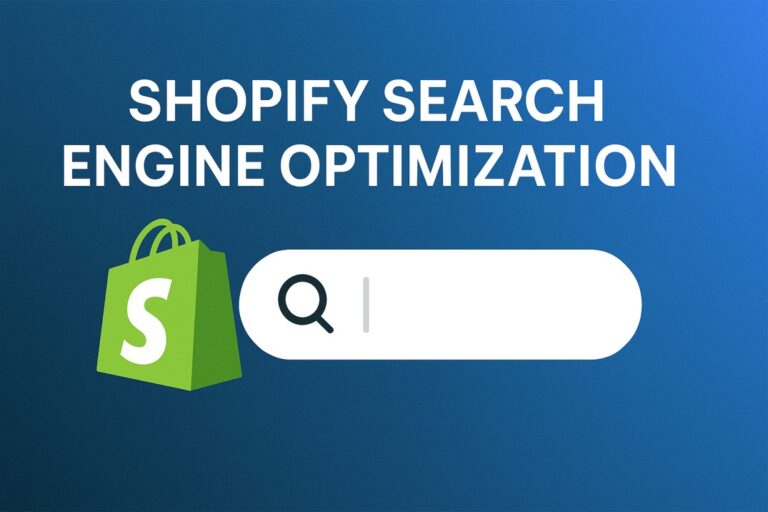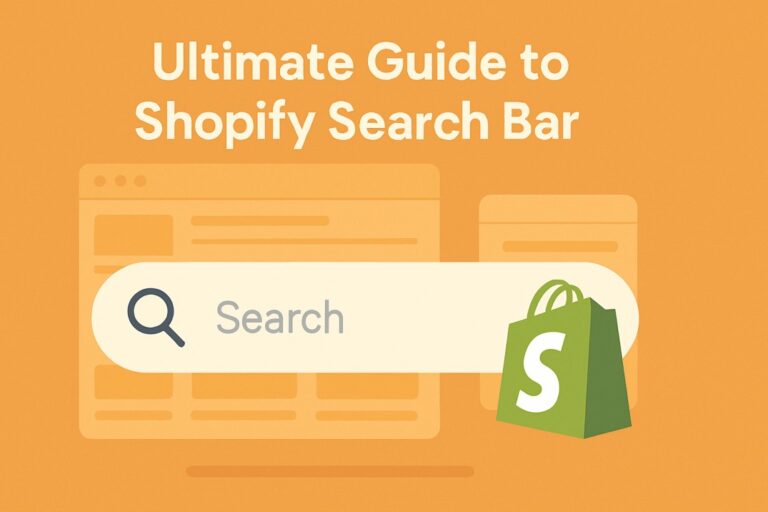Get Shopify search analytics provides with a single click! Are you the one who wants to get search analytics hassle-free? You land at the right place. Here’s how you can get Shopify search analytics in less than 5 minutes. Proof attached.

Get Shopify Search Analytics in 5 minutes
Using Expertrec Smart Search Bar
It is the easiest way to get search analytics since Expertrec Smart Search Bar is listed on the Shopify app store. It gives unlimited ajax search, filters, and voice search along with search analytics.
1. Click on the Expertrec smart search bar.
2. Go on to Add app -> Install app -> Start free trial.
3. That’s all. Open the Expertrec dashboard and access Shopify search analytics.
Using Expertrec Custom Site Search
Expertrec helps you in adding a highly customizable search site. On the dashboard, you can see the Analytics options that will show you relevant search analytics in an organized manner. As a result, it would be easy to understand and modify your on-site search-related strategies. Here’s how you can get access to the Expertrec search analytics at $9/month. The best part is that you can avail a 14-day free trial by signing up right away.
1. As always, first log in to your Shopify store and access the admin panel.
2. Click on Online Store -> Themes -> Actions ->Edit code.
3. In the layout folder, select the theme.liquid file. You will see a section of code on the right. We will add Expertrec code here to get Shopify search analytics.
4. Now, click on Expertrec Custom Site Search and log in with your Google account.
5. Enter your Shopify store URL and click on next to proceed.
6. Click on the Code section in the Install menu of the dashboard. Copy the code and the HTML tag.
<!--Shopify search analytics - Expertrec(.js - head)-->
<script>
(function() {
var id = 'Your_API_Key';
var ci_search = document.createElement('script');
ci_search.type = 'text/javascript';
ci_search.async = true;
ci_search.src = 'https://cse.expertrec.com/api/js/ci_common.js?id=' + id;
var s = document.getElementsByTagName('script')[0];
s.parentNode.insertBefore(ci_search, s);
})();
</scrip><!-- Shopify search analytics - Expertrec(HTML tag - body)-->
<ci-search></ci-search>7. You will get your API key once you log in to the Expertrec dashboard. Paste the code in the <head> section of theme.liquid and the HTML tag in the <body> section just between the two <div>. In the end, save the code.
Refresh your store and head on to the Analytics section to get access to all the search analytics.
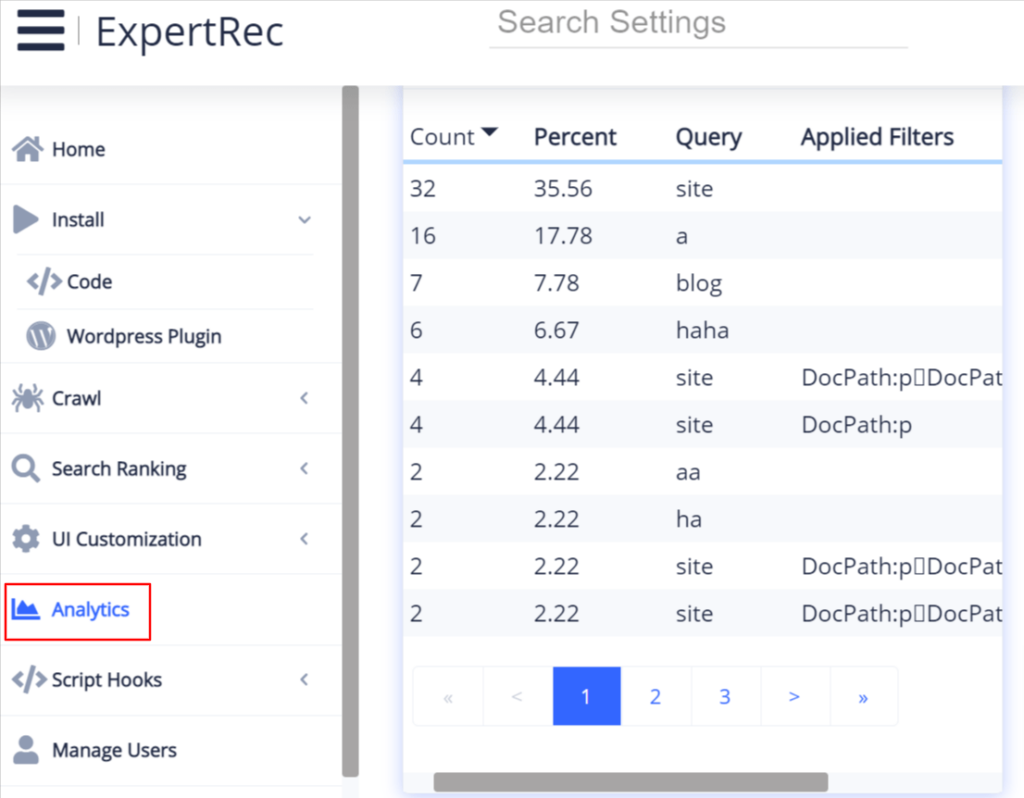
That’s all. You have successfully got search analytics access.
Using Google Analytics 3 (GA3)
To get site search analytics in GA3 follow these steps:
1. Open GA3 admin panel, click on Admin -> View settings. Drag down to get site search settings. Make sure that you have already entered your website URL and created a property for it.
2. Turn the toggle on and set a query parameter. Here ‘q’ is our query parameter. Save the settings.
3. Now, click on Behaviour -> Site Search -> Search Terms. Here, you will get the site search analytics. You can apply several filters to know the trending searched and when they are being conducted. Or, you can simply type search terms in the search bar to get the same result.
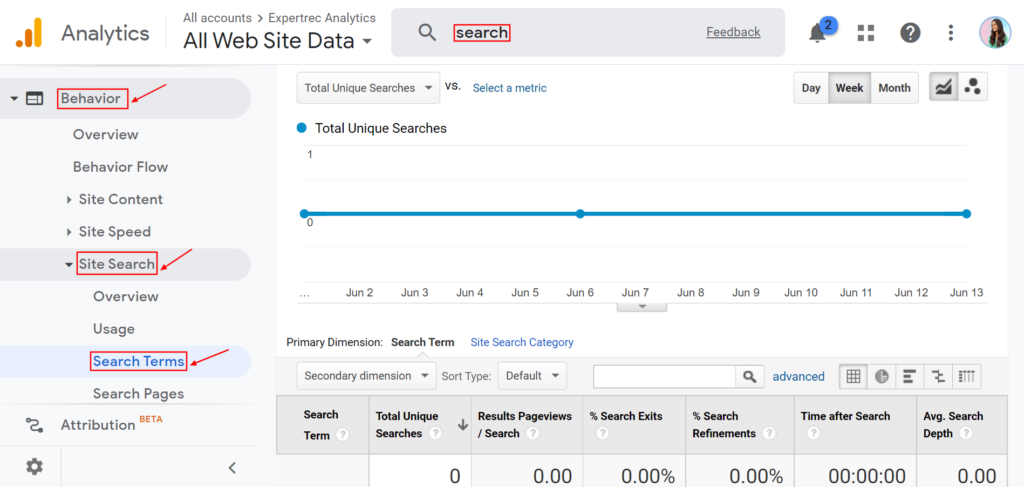
Although it’s a decent way to get on-site search analytics, we can’t deny the fact it involves several complexities. If you want the easy and quick way, then Expertrec search analytics provide a lot more valuable result that is not cluttered in any way. You get to see what really matters to you.
Using Google Analytics 4 (GA4)
Do you know you can set up site search analytics for your Shopify store?
Warnings: Merely enabling the site search in Enhanced measurement is not enough.
Here’s the step-by-step guide:
1. Open Google Analytics and select your Shopify store to enable site search analytics.
2. Click Admin -> Data Streams. Select your data stream.
3. In Webstream details, click on Enhanced measurement setting. Here, site search is enabled by default and it means that Google Analytics is tracking the site search. Here are 5 query parameters as q,s, search, query, and keyword. You can also add yours one by separating each by a comma.
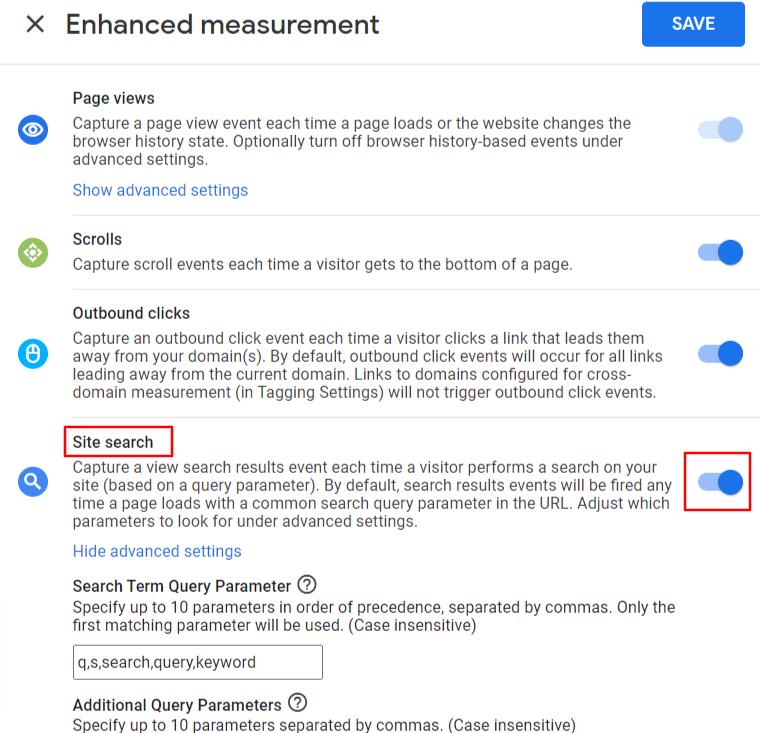
Let’s look at how this functionality works in actions
I’ve connected Google Tag Manager to get the preview in Debug view. You set up and install the tag manager from here.
4. Connect Tag Manager with your store and click on preview.
5. After that, open Google Analytics Debug View.
6. Click view_search_results -> search_terms. You can track the events and what kind of keyword your store visitors are looking for.
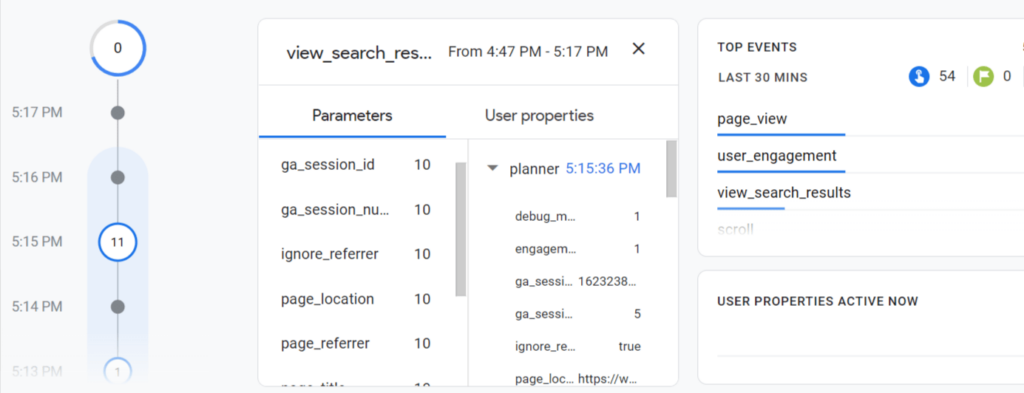
But you need to do something more to see the search term data in your google analytics as it won’t be shown by default. For using this parameter for reports, you need to register this parameter as the custom dimension.
7. Click on Custom definitions in the dashboard and click Create a custom dimension. Enter dimension name as search_term and event parameter as search_term.
That’s all. Click on Events and select view_search_terms to see the reports.
NOTE: You will have to wait up to 24 hours to actually start seeing this parament in the reports.
Here’s a video explaining the steps to get site search reports of your Shopify store.
FAQ
What exactly is Shopify search analytics? Can I use Google Analytics with Shopify??
To understand Shopify search analytics, we can take an instance of Google analytics. Here, we can easily track the website activity, including session duration, bounce rate, traffic source, and many other stats. It gives a broad picture of your website performance through which you can determine the ideal buyer persona (of course, based on those stats) and dig that goldmine into attracting more visitors.
Similarly, Shopify search analytics deals with uncovering relevant data related to searches performed by website visitors. There’s a quite thick line between Shopify analytics and Shopify search analytics. The noteworthy point is that Shopify analytics gives you insight about the store, visitors’ behavior, report of transactions and numerous things that can count on your side. But that’s the behind-side story. Before it, we have to know what visitors are trying to find in your store.
It is similar to finding “Why.” Why does a visitor is landing at your online store? It could be the need for certain products or services that works for him. But, there can be numerous reasons. And, to find the exact “why,” the Shopify search analytics can heavily help you make a relevant estimate.
What is the easiest way to get Shopify search analytics?
And, here’s the best part. Expertrec can really help you in getting quick stats focussed on on-site search in an easy and organized manner. It has the option at the top right to select stats from the Past day, past week, past month, or you can set your custom range and get the data to analyze the result. The General stats deals with showing you total searches, users, and queries in that given domain. And after it, you can get the data and export it to wherever you want. Even, you can integrate Google Analytics to Expertrec Search Analytics if you want to see all the data in an integrated format.
How to set up Google Analytics for my Shopify store?
Here’s how you can set up Google Analytics for your Shopify store using a long yet useful method. It is a pretty straightforward approach aiming to measure and record data related to the website, visitors’ behaviour on your online store and a plethora of things.
Check whether your Shopify account is already integrated with Google analytics
So, now the first step is to head on to Google analytics and sign up if you do have a Google Analytics for your Shopify store right now.
To know whether your shop is integrated with Google analytics or not, log in to your Shopify store admin panel and head over to Online store -> Themes.
On the right-hand side, click on Actions and click on Edit code in the drop-down options.
In the layout folder, click on the theme.liquid file. If you would already have a Google Analytics account integrated with it, you could find these tags: ga.js, gtag.js, analytics.js or dc.js. So, if you get any of these tags in the theme.liquid file, then it means you already have Google Analytics enabled and now you can skip the signup step. If the answer is no, then let’s move on to the next step.
Head on to Google Analytics
1. Sign up to Google Analytics for free and enter your account name and click Next.
2. In the Property setup, enter the name of your business and set the other options according to your demographic. You can create multiple properties under the same account name. Click on Next when you are done.
3. Accept the terms and conditions and mark the options with which you are like to continue. If you don’t want any of them, then click on Save.
You are shifted to the Analytics dashboard, where you can see a lot of options.
Create a data stream
1. Now, you have to create a data stream. To do it, open the Analytics Admin panel. Then, click on Data streams.
2. Right here, set up a data stream on the Web (if you want to collect web data only). Well, this section is quite new to Analytics and there are no major changes. At the end of the day, you just need to install a piece of code on your Shopify store. First, enter your Shopify store URL and enter the stream name. After that, click on Create stream.
3. Previously what we used to do was to copy the measurement ID and paste it into Shopify store preferences -> Google Analytics account. However, because of the recent update, this task has become a little bit more hectic. So, rather than copying the measurement ID, we will click on the Global Site Tag and copy that code by clicking on the clipboard icon.
<!-- Global site tag (gtag.js) - Google Analytics -->
<script async src="https://www.googletagmanager.com/gtag/js?id=G-0C6C51M5FF"></script>
<script>
window.dataLayer = window.dataLayer || [];
function gtag(){dataLayer.push(arguments);}
gtag('js', new Date());
gtag('config', 'G-0C6C51M5FF');
</script>Copy the code in the Shopify store
1. Head back to your Shopify store and click on Online Store -> Themes -> Edit code. Here’s something you can do because your site may crash by adding this code. While this is really rare but to be tension-free, click on Actions-> Duplicate, and you will have a copy of your recent theme. After that, you can make the changes as specified. Talks apart, In the layout folder, click on the theme.liquid. Now, our main aim is to inject this copied code here. So, paste that code just below the <head> section.
2. Save the code. Now, take a view of your Shopify store. And, return back to Google Analytics, where you will get all the stats.
You can see the Analytics as shown below:
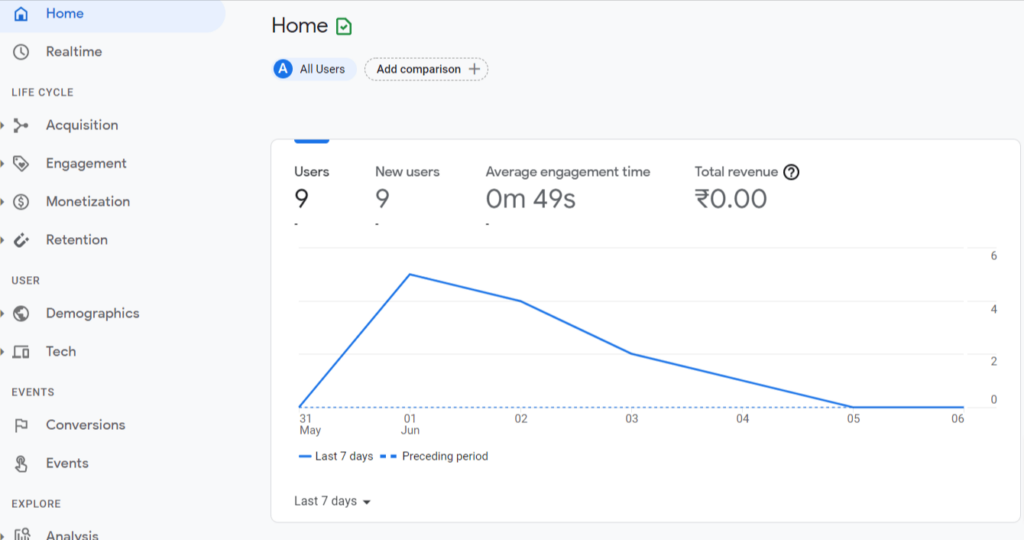
What is the best way to get Shopify search analytics?
Expertrec is way better than Google Analytics if you want site search analytics. It’s worth mentioning that Expertrec is the easiest and quick way to integrate your Shopify store with search analytics and get access to it within 5 minutes.
I hope this blog has resolved your issue, and now you can access Google Analytics and integrate it with your Shopify store. But, the essence of this blog post is that having an on-site search is essential, and it will certainly count on your side if you start analysing the data coming from it. You can utilize it to understand the customers’ demands and behaviors and thus can get a better understanding in the pretty world of marketers.
So, what are you waiting for? Click below and sign in with your Google account to Expertrec dashboard and witness numerous benefits that are not mentioned here. Then, go ahead and explore it in your own way.



